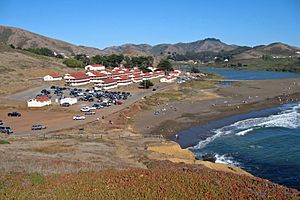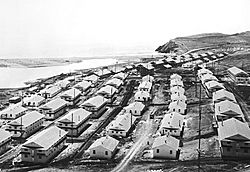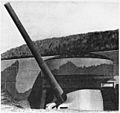Fort Cronkhite facts for kids
Quick facts for kids Fort Cronkhite |
|||||||||||||||||||||||
|---|---|---|---|---|---|---|---|---|---|---|---|---|---|---|---|---|---|---|---|---|---|---|---|

Fort Cronkhite in the Marin Headlands in Sausalito, CA. 2012
|
|||||||||||||||||||||||
| Lua error in Module:Location_map at line 420: attempt to index field 'wikibase' (a nil value). | |||||||||||||||||||||||
| Location | Sausalito, California, United States | ||||||||||||||||||||||
| Operated by | National Park Service | ||||||||||||||||||||||
|
|||||||||||||||||||||||
Fort Cronkhite is a cool place in California's Golden Gate National Recreation Area. It used to be a US Army base. During World War II, soldiers here protected the San Francisco Bay Area. They used big guns and radar to guard the coast. Today, it's a park managed by the National Park Service.
Contents
Fort Cronkhite: A Historic Army Post
Fort Cronkhite was named after a famous army general, Adelbert Cronkhite. It was built in the late 1930s.
Building the Fort for World War II
In the early 1940s, the United States Army grew very quickly. They needed many places for soldiers to live and train. So, tens of thousands of temporary wooden buildings were built across the country.
The army's building teams, like the Corps of Engineers, used special plans. This helped them build different types of buildings very fast. These included barracks (where soldiers slept), mess halls (where they ate), and places for fun.
Many of these "temporary" wooden buildings are still standing at Fort Cronkhite today, over 70 years later! The first soldiers arrived in June 1941. They were part of the 6th Coast Artillery. These soldiers operated large guns and anti-aircraft batteries to protect the area.
Battery Townsley: Protecting the Coast
Battery Townsley was named after another important general, Clarence Page Townsley. He led soldiers in World War I.
- Construction of this battery began in 1938. Workers dug out a huge space for the gun and its ammunition.
- It was finished in 1940. It became the second "16-inch battery" on the West Coast. This means it had very large guns, 16 inches wide!
- Soldiers lived inside the concrete walls of the battery. They were always ready to defend the coast.
You can visit Battery Townsley! It's open to the public on the first Sunday of every month, from 12 noon to 4 PM.
Fort Cronkhite After World War II
After World War II, during the Cold War, Fort Cronkhite was still used by the army. It housed soldiers who worked at the nearby SF-88 missile site.
The SF-88 site had Nike Missiles. These were used to defend against air attacks. The missile site operated through the 1960s and early 1970s.
In 1974, the SF-88 missile site closed. Many of the old wooden buildings at Fort Cronkhite had already been taken down. Soon after, Fort Cronkhite was officially closed as an army base.
When the Fort Closed Down
Fort Cronkhite stopped being a United States Army base on September 10, 1974.
Fort Cronkhite Today: A National Park
Today, Fort Cronkhite is part of the National Park Service. It's in the Marin Headlands area, which is part of the Golden Gate National Recreation Area.
Fort Cronkhite, along with nearby Fort Baker and Fort Barry, is listed on the National Register of Historic Places. This means it's an important historical site.
Visitors can explore the area and learn about its past.
- You can take walking tours of the old army buildings.
- There are many trails for hiking.
- Some buildings are used by private groups and are not open to the public.
Near Fort Cronkhite is Rodeo Beach. This beach is very popular for surfing and is close to San Francisco. Rodeo Lagoon is also nearby. You can also find campgrounds in the Marin Headlands area if you want to stay overnight.
Images for kids









